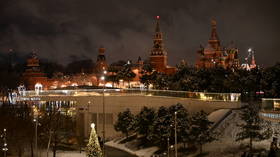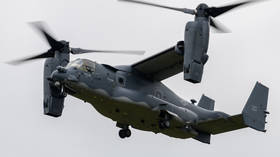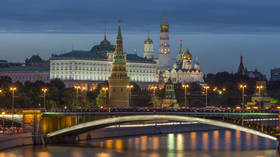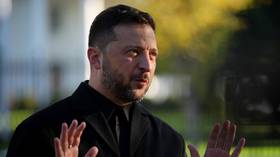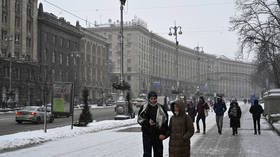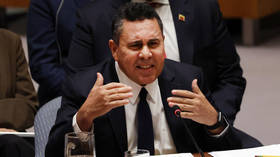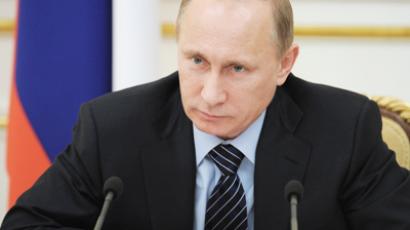Being strong: National security guarantees for Russia
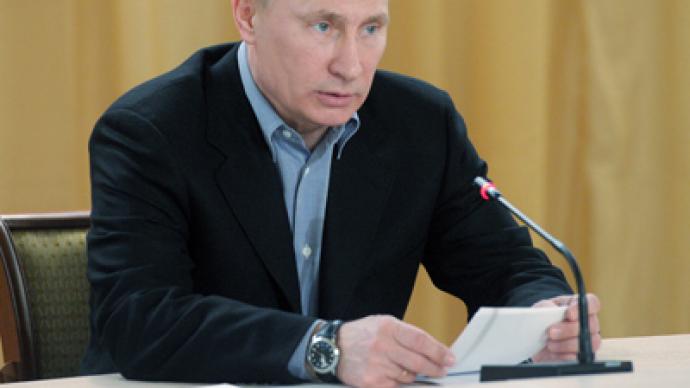
Russian premier and presidential hopeful Vladimir Putin has outlined his ideas on developing Russia’s defenses in an article published Monday in Rossiyskaya Gazeta.
The world is changing. The processes of global transformation currently underway may carry all sorts of risks with them, many of them unpredictable. In a situation of global economic and other kinds of hardships, it may be very tempting for some to resolve their problems at others’ expense, through pressure and coercion. It is no wonder that we already hear some voices saying that it is “only natural” that resources of global significance should soon be declared as being above national sovereignty.We must exclude any such possibility, even a hypothetical one, with respect to Russia. This means that we should not tempt anybody with our weakness.This is why we will under no conditions give up our strategic deterrent capability. On the contrary, we will strengthen it. It was this capability alone that enabled us to maintain our national sovereignty during the extremely difficult period of the 1990s, when, let’s face it, we did not have any other weighty material arguments.Obviously, we will not be able to strengthen our international standing, develop our economy and democratic institutions, unless we are able to protect Russia – unless we consider the risks of potential conflicts, secure our self-sufficiency with respect to military technology and prepare a strong and appropriate military response as an extreme measure when responding to a challenge.We have adopted and are implementing unprecedented programs for developing our Armed Forces and modernizing Russia’s defense industry. Overall, we will allocate approximately 23 trillion rubles for these needs over the next decade.To be frank, we had many discussions regarding whether such large-scale allocations were necessary and timely. I strongly believe that we have enough resources and we can afford it. More importantly, we can no longer delay our efforts to create a modern Armed Forces and comprehensively strengthen our defensive potential.This does not mean that we are militarizing Russia’s budget. Essentially, by allocating these funds today, we are compensating for the years when the Army and the Navy were regularly underfunded, when we practically did not purchase any new weapon systems – while other countries were consistently building up their military might.
A smart defense against new threats
We need response mechanisms not only for the dangers that already exist. We need to learn to look ahead, “over the horizon,” and estimate threats for 30-50 years ahead. It is a serious task that requires that we mobilize the resources of civilian and military science and algorithms of reliable long-term forecasting.What kind of weapons will the Russian Army need? What kind of technical requirements will our defense industry have? Essentially, we need to create a fundamentally new, smart system of military analysis and strategic planning that will offer recommendations and expediently implement them through our security agencies.So, what does the future have in store for us?The probability of a global war between nuclear powers is not high, as that would mean an end to civilization. As long as we keep the “powder” of our strategic nuclear forces, produced by the hard labor of our fathers and grandfathers, dry, nobody will dare to launch a large-scale aggression against us.Yet we should take into account that technological progress in various areas, from new models of weapons and military hardware to information and communications technology, has fundamentally changed the nature of armed conflict. For instance, as high-precision long-range weapons with conventional charges become more common, they will become the means of achieving a decisive victory in conflicts, including a global conflict.Space-based systems and IT tools, especially in cyberspace, will play a great, if not decisive role in armed conflicts. In a more remote future, weapon systems that use different physical principles will be created (beam, geophysical, wave, genetic, psychophysical and other types of weapons). All this will provide fundamentally new instruments for achieving political and strategic goals in addition to nuclear weapons. Such weapon systems will be as effective as nuclear weapons but will be more “acceptable” from the political and military point of view. Therefore, the strategic balance of nuclear forces will gradually lose its significance in the matter of deterring aggression and chaos.Today, we see how new regional and local wars break out one after another. We see zones of instability and artificially maintained, managed chaos emerging. Furthermore, we see how some are purposefully provoking such conflicts in the immediate vicinity of Russia’s borders – and those of our allies. We see the fundamental principles of international law being devalued and eroded, especially in the matter of international security.Under such conditions, Russia cannot rely on diplomatic and economic methods alone to remove contradictions and resolve conflicts. Our country faces the task of developing its military potential in keeping with the deterrence strategy and at the level of defensive sufficiency. Our Armed Forces, special services and other security agencies should be prepared to provide quick and effective responses to new challenges. It is a necessary requirement for Russia to feel secure and for our partners to listen carefully to what our country has to say in various international formats.Also, together with our allies, we should strengthen the capabilities of the Collective Security Treaty Organization, including the Collective Rapid Response Forces. The CSTO is ready to fulfill its mission of the guarantor of stability in Eurasia.Securing the dynamic development of the Armed Forces, the nuclear and space industries, the defense industry, military education, fundamental military science and applied research programs will remain a key priority of Russian government policy for year to come.
The Army has preserved Russia
The disintegration of the Soviet Union and the social upheavals of the 1990s affected all government institutions. Our Army went through several trials as well. There was practically no combat training. The units that used to make up the “first strategic echelon” in Eastern Europe were redeployed to unprepared locations. And since there was no money to prepare places for them, to build new military bases, training grounds and houses, it was these elite and most combat-ready units that were sacrificed.Officers would go unpaid for months. To be completely frank, quite often it was a problem even to provide food for the personnel. Tens of thousands of servicemen retired. The number of generals, colonels, lieutenant colonels and majors exceeded the number of captains and lieutenants. Defense factories were standing idle, accumulating debts and losing their most valuable, one-in-a-million specialists.The Armed Forces came under a devastating information attack. Some people simply could not live a single day without insulting and humiliating the Army, offending everything that has to do with things like the Oath, duty, serving the Homeland, patriotism and the glorious military history of our country. I have always considered it a real moral crime and an act of betrayal.We should always remember how our country is indebted to soldiers and officers who, against all odds, preserved the army throughout the extremely difficult period of the 1990s and kept its units combat-ready at crucial times. Whenever necessary, they went into battle. They would lose their comrades and defeat the enemy. This is what happened in the North Caucasus, in Tajikistan and in other hotspots. These people preserved the spirit and the honor of the Army. They preserved Russia’s territorial integrity and sovereignty. They protected the security of our citizens. They saved our country from humiliation and being written off.Yet the Army had to pay a great price for mistakes that happened during numerous and inconsistent reforms, which were often limited to mechanical reduction.In 1999, when gangs of international terrorists directly attacked Russia, we found ourselves in a tragic situation. To put together a 66,000-strong task force, we had to scrape it up, literally, piece by piece, with composite battalions and detached companies. Nominally, the personnel of the Armed Forces exceeded 1,360,000. Yet we had practically no combat-ready units that would be prepared to go into action without additional preparations.Yet the Army fulfilled its mission. Our officers, sergeants and soldiers, those to whom the Oath mattered more than their life, health and well-being, fulfilled their duty. Most importantly, policymakers and ordinary people finally realized one simple truth: you must treasure the Armed Forces. You have to strengthen them; otherwise, you will have to “feed somebody else’s army” or even be enslaved by bandits and international terrorists.We started with the most urgent things. We restored the system of basic social guarantees for servicemen. We put an end to shameful delays with salary payment. Year after year, we increased the share of Army and Navy allocations in the budget – and this after a period of time when there was no money even for the most urgent needs!I remember 2002, when the chief of the General Staff suggested (because of material difficulties, of course) shutting down a naval base for our strategic submarines in Kamchatka. That would have left us without sea-based nuclear forces in the Pacific. I decided against it. Since there was no money available in the budget, we had to ask private corporations to help. I would like to thank them today. Surgutneftegaz and TNK without any hesitation offered enough funds to start rebuilding the base. Later, the government was able to provide some funds. Now we have a modern base in Vilyuchinsk, where next-generation submarines of the Borei class will soon go on combat duty.In every strategic area, we have formed special units that are always combat-ready and that are manned with professional troops only. We have created self-sufficient combat groups. It was such a group that carried out the peace enforcement operation with respect to Georgia and protected the people of South Ossetia and Abkhazia in August 2008.But the experience of past years had demonstrated that the potential of the old military structure that we had inherited from the Soviet Union had been exhausted. What was that structure, essentially? Thousands of depots, arsenals, warehouses, numerous headquarters and undermanned units. In a word, everything needed for a mobilization-type, multi-million strong army of the past century.It was useless to feed manpower and equipment into the old structure; there would simply not be enough financial and human resources. Most importantly, it did not meet even today’s requirements, let alone those of the future. Had we decided not to change anything, and limited ourselves to gradual and partial reforms, we could have sooner or later lost our military potential entirely. We could have lost the Armed Forces as a viable organism.There was only one way out: to build a new Army. We needed a modern, mobile and constantly combat-ready army. It was a very difficult process that affected tens of thousands of people. This inevitably involves mistakes, offenses and discontent. Public reaction was strong, including in the Army community itself. It is not one person or ten people that carry out the reform. We are changing an extremely complex institution that has accumulated lots of defects. All kinds of errors, excessive zeal on the part of certain officials, insufficient information and the lack of feedback channels, formal implementation of instructions – these are all real problems of the current reform. We must identify all these problems and adjust certain decisions, at the same time continuing the general policy of systemic reforms in the Armed Forces.
What has been accomplished
We no longer have undermanned units in the Army. We have more than 100 brigades of general and special types in the Ground Forces. These are full-fledged combat units that are fully manned and have all the necessary equipment. They are expected to be ready to move out one hour after they receive their orders. The standard time for relocation to a potential theater of operations is 24 hours.Formerly, units needed up to five days to get ready for a combat mission. The process of supplying all undermanned units with personnel and equipment to bring them up to “wartime standards” was expected to take almost a year. And this – in a situation where most conflict today last a few hours to a few days!Why did we pick the brigade as our main tactical unit? First of all, based on our experience in Afghanistan and other campaigns, where instead of regiments and divisions, mobile assault groups provided with close air support and other auxiliary units proved to be the most effective unit.The new brigade is smaller than a division, yet its attacking power is greater. It has much more firepower and more support units – artillery, air defense, reconnaissance, communications, etc. A brigade can operate autonomously or as a part of a bigger unit. I agree that their quality may not always be perfect. But soon we should be able to meet the standard completely.The Russian Army is getting rid of secondary, additional functions like economic or maintenance activities. Everything that distracts from combat training has been reduced to a minimum. Considering that we have reduced the term of service for conscripts to 12 months, this is the only way we can turn a rookie into a well-trained soldier. Soldiers and officers should be occupied with their immediate task, i.e., intense combat training and learning. This will also increase discipline and order in the Army and improve the reputation of the conscription service.A serious reform of military education is underway. We are establishing ten major research and educational centers. All these institutions are part of a clear top-down system, and depending on their progress officers have an opportunity to receive advanced training. This approach is based both on our own traditions and international practice.Without seriously developing our military research, we would be unable to have an effective military and military-technical doctrine. The General Staff would be unable to work effectively. We must recover the lost competencies of military institutions, integrating them with the developing system of military education, just like in the civilian sector of the economy. Military science should play a defining role in formulating tasks for the defense industry. Competent procurement agencies, the services of the Defense Ministry that are in charge of the defense order, should effectively formulate technical requirements for designers and manufacturers and supply them with desired characteristics of future weapons and military hardware.Of course, normal development of military research would be impossible without partnership with civilian science, without using the potential of our leading universities and research centers. Scientists should have enough information about the current condition and future prospects of the Army and its weapons systems to advance their promising research projects, considering the possibility of applying them in the defense industry.I would like to point out that administrative bodies in the Armed Forces have been slashed by fifty percent. We have established four big military districts: West, South, Center and East. They are in charge of the appropriate Air Force, air defense and Navy units. Essentially, these are operational-strategic commands. On Dec. 1, 2011, a new branch of the Armed Forces, the Aerospace Defense Forces, went on combat duty.The Air Force has created seven major bases with solid infrastructure. The airfield network is being upgraded. We have repaired 28 airfield over the past four years – for the first time in twenty years. This year, we plan to repair another twelve military airfields.We have seriously boosted the capabilities of our early warning system. New radars in St. Petersburg, Kaliningrad and Armavir are on combat duty now, and another one is being tested in Irkutsk. All aerospace defense brigades are equipped with the modern Universal-1S computer system. The entire fleet of Glonass satellites has been deployed in outer space.We have secured the reliability and sufficiency of our land-, sea- and air-based components of Russia’s Strategic Nuclear Forces. The share of modern land-based missile systems has grown from 13% to 25% over the last four years. Another 10 missile regiments will soon be equipped with Topol-M and Yars strategic systems. The Long-Range Aviation Command has retained its fleet of Tu-160 and Tu-95ms strategic bombers. They are currently being upgraded. We have commissioned a new long-range air-to-surface cruise missile for our strategic bombers. Since 2007, we have resumed regular missions by our strategic bombers in combat patrol areas. We have started developing a promising aviation system for the Long-Range Aviation Command.Strategic submarines of the new Borei class will soon go on combat duty. Two submarines of this class, the Yury Dolgoruky and the Aleksandr Nevsky, are already going through sea trials.Our Navy has resumed its presence in the strategic areas of the World Ocean, including the Mediterranean Sea. This demonstration of the “Russian flag” will be regular now.
Goals for the decade
We have embarked on a large-scale and comprehensive re-equipment of the Army, Navy and other military services ensuring our national security. The list of priorities includes nuclear forces, aerospace defense, systems of communication, intelligence, control and radio warfare, unmanned aerial vehicles and combat units, state-of-the-art transport aviation, personal protective gear, high-precision weapons and means of countering them.Training programs for command units and troops should be streamlined to enhance their quality, make them more intensive and extensive. We need to focus on building effective multi-service units and boosting combat readiness. Our specialists will have to lay out a future vision for the development of services and branches and define their goals and objectives in key guidelines. There is little doubt, though, that the role of the nuclear deterrent forces will remain unchanged. At least, until we design and adopt next-generation weapons and combat units, including high-precision weapons, whose capabilities, as I mentioned earlier, are close to those of nuclear deterrent forces. The next decade is also bound to see the growing role of the Navy, the Air Force and Aerospace Missile Defense. We are forced to take decisive steps to bolster our national aerospace defense system to counter the U.S. and NATO efforts in the deployment of missile defense. To secure the existing global balance of forces, we need either to design a domestic missile defense system, which will be a costly and yet ineffective one, or to protect our retaliatory potential by developing a capability to overcome any missile defense. This is the exactly the task of the Strategic Nuclear Forces and aerospace defense units. One cannot be ‘too patriotic’ about this issue. Russia’s military response to the global U.S. missile shield, including its European part, will be effective and asymmetrical, a match for U.S. missile defense policy.Our goal is the revival of a Navy capable of service in the Arctic Ocean and in the Pacific. The leading military powers have intensified their activities in the Arctic, which forces Russia to secure its interests in the region.In the upcoming decade, Russia will deploy more than 400 advanced ground and sea-based intercontinental ballistic missiles, eight nuclear-powered ballistic missile submarines, some 20 multi-purpose submarines, more than 50 combat ships, some 100 military spacecraft, more than 600 advanced aircraft including fifth-generation fighters, more than a thousand helicopters, 28 regimental kits of the S-400 anti-aircraft missile system, 38 battalion kits of the Vityaz air defense system, 10 brigade kits of the Iskander-M ballistic missile system, more than 2,300 modern tanks, some 2,000 self-propelled artillery vehicles and guns, and more than 17,000 military motor vehicles. Today, more than 250 military units, including 30 air force squadrons, are using advanced military equipment. By 2020, the share of new armaments should be no less than 70 per cent. The systems remaining in operation will be significantly upgraded.By and large, the goal for the decade is to equip our Armed Forces with next-generation armaments, which boast better visibility, higher precision, and faster response than the similar systems of any potential adversary.
The social dimension of the Armed Forces
A modern Army must employ qualified personnel with the skills to operate start-of-the-art armaments. These specialists must demonstrate profound knowledge and high educational and cultural levels. Individual requirements for every officer and soldier have significantly risen today.In their turn, servicemen are entitled to the full package of social benefits matching the huge responsibility they bear. These include access to general healthcare, health resort treatment, medical insurance, a decent pension and job opportunities after retirement. Their pay must be on par or even higher than that of the qualified specialists and managers in the leading industries of our economy.In 2007, the government decided to increase military pay and pensions. At the first stage of the reform, in 2009, the government set out on a large-scale experiment to raise the pay for those who bear a special responsibility for keeping our country in safety.Now, since January 1, 2012, we took another step – military pay has almost tripled. The Armed Forces, as an employer, are becoming ever more competitive, changing the status quo and making army service more appealing. Since January 1, 2012, officers within the Interior Ministry are also entitled to a pay raise. Other branches of the military, law enforcement and special services will see a pay rise from January 1, 2013.The pensions of all retired military servicemen, regardless of the agency they served in, have grown 1.6 times since January 1, 2012. In the future, military pensions will be increased annually, at a rate of no less than two per cent above the inflation level. Apart from that, we will introduce a special education certificate so that every retired serviceman can get a chance to study or attend courses at any Russian educational institution. Housing is a separate issue. For many years, it was neglected. In the 1990s, making use of all the resources available, the government provided only 6,000-8,000 apartments or housing certificates a year. Very often, people had to retire without any housing options – they were put on the same waiting list as civilians, a line which never moved forward. If we look back, we can see that the housing volumes have grown significantly since 2000. Every year, up to 25,000 servicemen received an individual apartment. However, it was clear that we needed a drastic change in policy; we needed to pool our financial and organizational resources.The first step was the presidential program called 15+15, implemented in 2006-2007, when servicemen received some 20,000 apartments in those regions where the housing issue was most acute.Between 2008 and 2011, the Ministry of Defense alone acquired and constructed some 140,000 apartments for permanent and service housing. It’s an unprecedented figure. The government allocated funding for the program even during the crisis years. But even as we expanded the program, we have not been able to get the issue under control. We must be sincere about the reasons for the delay. Firstly, the records of officers in need of housing were poorly kept by the Ministry of Defense. And secondly, the pace and deadlines of our actions were not always in line with housing opportunities. So we must remedy the situation.In 2012 and 2013, we must provide apartments for permanent residence for all the remaining officers on the waiting list. By 2014, we will solve the problem of service housing. These efforts will help to close the ‘eternal’ housing issue for Russian servicemen. Also, by late 2012, we plan to provide apartments to those servicemen who retired in the 1990s without any housing and are still on municipal waiting lists. At the moment, there are more than 20,000 such officers.Those who joined the Armed Forced after 2007 will be eligible for an apartment according to schedule and on the basis of mortgage schemes. The current figure stands at 180,000, with more than 20,000 apartments already purchased. Another acute issue is military towns and the destiny of thousands of people residing there. These include former servicemen and their families, pensioners, civilian staff – all those who dedicated decades of their lives to the Army and the country.It is unacceptable when these settlements, with all their problems, are just dumped by the Ministry of Defense onto the shoulders of regional and municipal authorities. We need to carry out a thorough examination of all the Armed Forces property that is to be handed over to civilian authorities. In other words, the Ministry of Defense must renovate residential apartment blocks, preschools, utility and housing facilities, before handing them over to municipal authorities. It must also provide financial resources for routine maintenance.The Armed Forces recruiting system will be overhauled. Today, there are 220,000 contract officers and 186,000 contract soldiers and sergeants. The Ministry of Defense is going to recruit another 50,000 contract servicemen to be appointed as sergeants and sergeant majors, also including technicians in charge of operation of combat vehicles. Selection will be multi-stage and extremely tough. As Soviet Marshal Georgy Zhukov once said, “It’s me and the sergeants who are in command of the Army.” Non-commissioned officers are the backbone of the Army, supervising discipline and combat training. This position must be awarded to worthy servicemen who have the appropriate moral, physical and educational levels. Contract soldiers, as well as NCOs, will undergo training at special centers and sergeants’ academies. By 2017, out of one million servicemen in the Russian Army, 700,000 should be professionals – officers, graduates of military academies, sergeants and contract soldiers. By 2020, the number of conscripts will drop to 145,000.The rationale underpinning the reforms is clear – we seek to build a fully professional army. But it is also clear that a professional army is an expensive one. This is why a mixed recruitment system for the short-term is a necessary compromise between the goals we have set and the nation’s current opportunities.But conscription must change, too. This is part and parcel of the ongoing military reform.A new law enforcement body, military police, is being set up to monitor discipline in the army. We must also engage civil, veterans’, religious and human rights organizations to help educate servicemen, protect their rights and interests and build a healthy moral environment in the army.To serve this purpose, we also need to develop the institute of chaplains. Chaplains must be deployed at every military unit.We are aware that the current conscription service is fraught with social inequality. Among those drafted are mainly teenagers from poor working or farming communities, those who did not make it into a university or college and could not use the right to a deferment. We need to boost the prestige of active duty service so that young people will start viewing it as a privilege, not an obligation.Servicemen must also receive additional preferences at Russia’s best universities if they want to study after retirement. They will be eligible for government-funded extra training to help them pass exams. Those who were drafted into the army after graduation will receive state grants so that they can study at the best Russian and foreign business schools. They will also get preferences if they want to apply for a job in the public sector or get on the list of managerial reserves. The Army must reclaim its traditional role as a major springboard for a career.For the future, we need to consider such a concept as ‘trained reserve service.’These reserve members, as it is the case in many countries, will have to undergo regular, not occasional – as is practiced now – training to be ready to join combat units at any time.For the time being, we do not have any clear-cut concept of the national reserve of the Armed Forces. So our short-term objective will be to draft it up and make it available for public discussion.Now, a few special words about the Cossacks, a large group counting millions of Russians. Historically, Cossacks served the Russian state by defending its borders and taking part in military campaigns of the Russian Army. Following the 1917 Bolshevik Revolution, the Cossack community was subjected to brutal repression, which was actually genocide. But the Cossacks survived and retained their culture and traditions. The mission of the state now is to help the Cossacks, draw them into military service and educational activities for youths, involving a patriotic upbringing and initial military training.There is no denying, the Army must become professional, relying heavily on contract servicemen. Still, we cannot abolish the notion of the honorable military duty for the male population. They must be ready to stand up to defend their homeland in the time of danger. We need to reconsider the system of initial military training and the patriotic upbringing of Russian schoolchildren, development of military-related sports and physical training in general. Conscription service lasts just 12 months, and soldiers must focus entirely on combat training. It means that those who are drafted need to be physically fit, healthy, possessing basic computer skills and an ability to operate a vehicle. In this respect, I would like to recognize the work done by DOSAAF, Russia’s Voluntary Association for Assistance to Army, Air Force and Navy.Federal, regional and municipal agencies must provide all kinds of support to this organization. We need to combine the efforts of government agencies and societal groups. This is why I support the idea to set up a Voluntary Association of the National Front for Assistance to the Army, Navy and Defense Industry.Our goals in defense and national security cannot be achieved without high morale and motivation both in the army and the defense plants producing modern weaponry, or without respect for the Armed Forces and for military service in Russian society.
The rest of the article is forthcoming shortly on our website.


